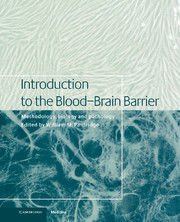Book contents
- Frontmatter
- Contents
- List of contributors
- 1 Blood–brain barrier methodology and biology
- Part I Methodology
- Part II Transport biology
- Part III General aspects of CNS transport
- Part IV Signal transduction/biochemical aspects
- Part V Pathophysiology in disease states
- 41 Cerebral amyloid angiopathy
- 42 Brain microvasculature in multiple sclerosis
- 43 Hemostasis and the blood–brain barrier
- 44 Microvascular pathology in cerebrovascular ischemia
- 45 HIV infection and the blood–brain barrier
- 46 Hypertension
- 47 The blood-brain barrier in brain tumours
- 48 The pathophysiology of blood–brain barrier dysfunction due to traumatic brain injury
- 49 Cerebral malaria and the brain microvasculature
- 50 Molecular basis of tissue tropism of bacterial meningitis
- Index
49 - Cerebral malaria and the brain microvasculature
from Part V - Pathophysiology in disease states
Published online by Cambridge University Press: 10 December 2009
- Frontmatter
- Contents
- List of contributors
- 1 Blood–brain barrier methodology and biology
- Part I Methodology
- Part II Transport biology
- Part III General aspects of CNS transport
- Part IV Signal transduction/biochemical aspects
- Part V Pathophysiology in disease states
- 41 Cerebral amyloid angiopathy
- 42 Brain microvasculature in multiple sclerosis
- 43 Hemostasis and the blood–brain barrier
- 44 Microvascular pathology in cerebrovascular ischemia
- 45 HIV infection and the blood–brain barrier
- 46 Hypertension
- 47 The blood-brain barrier in brain tumours
- 48 The pathophysiology of blood–brain barrier dysfunction due to traumatic brain injury
- 49 Cerebral malaria and the brain microvasculature
- 50 Molecular basis of tissue tropism of bacterial meningitis
- Index
Summary
Introduction: the clinical syndrome of cerebral malaria
Examining the pathophysiology of disease in an organ often provides insight into its normal function. In the case of the central nervous system, infections that primarily affect the brain have yielded valuable information about cellular immune responses in the CNS, as in bacterial meningitis, and the potential mechanisms for cellular traffic across the blood–brain barrier, as in HIV encephalitis. Human malaria is another infection that can affect the brain, but in contrast to the viral encephalitides the pathogen remains exclusively within the vascular space of the brain, binding to cerebral endothelial cells and not entering the brain parenchyma.
Human malaria is caused by four Plasmodium parasites, of which P. falciparum is the commonest and most serious pathogen. Infection can be asymptomatic or lead to a mild febrile illness, but a small minority of patients suffer severe complications affecting a number of organs. In particular one of the most serious complications of severe disease is cerebral malaria. Using strict criteria cerebral malaria (CM) is defined as an acute, diffuse and potentially reversible encephalopathy with a decreased level of consciousness in the presence of proven infection with P.falciparum and in the absence of hypoglycemia or other CNS infection (WHO, 1990).
- Type
- Chapter
- Information
- Introduction to the Blood-Brain BarrierMethodology, Biology and Pathology, pp. 454 - 461Publisher: Cambridge University PressPrint publication year: 1998



